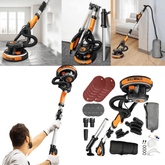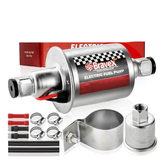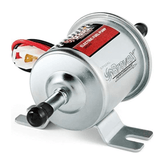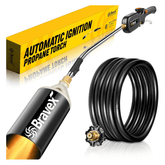How to Sand Drywall Without Dust Of 2 Methods
When undertaking home improvement projects or renovations, sanding drywall is an essential but often messy and cumbersome task. Are you tired of the traditional sanding methods that leave behind clouds of dust, making the air gritty and settling on every surface? No worry! We have two effective methods that will help you sand drywall without dust: wet sanding and dry sanding by using a drywall vacuum sander. Let's delve into these methods in detail.

Method 1. Wet Sanding
Wet sanding is a technique that involves using water to lubricate the sandpaper and prevent dust particles from becoming airborne. Here's how to perform wet sanding on drywall.

- Step 1. Prepare a drywall sponge. Use plastic drop cloths to protect the room from dust and get yourself a dust mask.
- Step 2. Submerge the drywall sponge in warm water and let it soak for a few minutes.
- Step 3. Start sanding the drywall surface using the wet drywall sponge. Keep the sponge and the surface wet by periodically dipping the sponge in the water.
- Step 4. Work in smooth, even strokes, applying gentle pressure. The water will mix with the drywall dust, forming a slurry that helps prevent dust from spreading.
- Step 5. Frequently rinse the drywall sponge in water to remove accumulated dust and ensure proper lubrication. Change the water as needed.
- Step 6. When you finish sanding, wait for the drywall to fully dry.
Wet sanding is indeed for reducing dust while sanding. However, it does have a few drawbacks. It can be very messy due to the water creating a slurry with sanding residue. Wet sanding also requires more physical effort and extends drying time, so it’s great only for smaller projects. If you prefer a superior dust-free drywall sanding method to work with big projects, consider exploring Method 2.
Method 2. Dry Sanding with a Dust-free Drywall Sander
Another more efficient method to sand drywall without dust is by using an electric drywall sander with a vacuum attached, which guarantees dust-free even after completing sanding. These innovative tools are specifically designed to minimize dust while improving sanding efficiency. Let's take a closer look at how to use them.
- Step 1. Prepare the work area by clearing furniture and covering surfaces with plastic sheets.
- Step 2. Put on safety gear, including goggles and a dust mask, to protect yourself from any remaining dust particles.
- Step 3. Choose a sandpaper with right grit. In general, start with a lower-grit sandpaper, such as 100 or 120, to address any high spots, imperfections, or excess joint compound. Then smoothly transition to a high-grit sandpaper like 180, 240 or higher to achieve flawlessly smooth wall surfaces.
- Step 4. Properly assemble your drywall sander. Ensure that the integrated dust collection bag or vacuum is properly connected and functioning.
- Step 5. Turn on the electrical drywall vacuum sander and begin sanding the drywall surface.
- Step 6. Once the sanding is complete, turn off the sander, carefully remove the dust from the dust collection bag, and clean up any remaining dust in the work area.
Tips on Using an Electric Drywall Vacuum Sander:
- Hold the electric drywall sander firmly and move it in smooth, even strokes across the surface. Avoid applying excessive pressure, as the sander's weight and motion should do the work for you.
- Work methodically in a circular motion, focusing on one area at a time. Periodically check the progress and adjust the sanding speed or sandpaper grit as needed.
- Regularly empty or replace the dust collection bag as it fills up.
- Be careful to prevent the sanding screen from coming into contact with sharp objects or protrusions such as screws and nails, as they have the potential to damage the pad.
What’s A Good Drywall Vacuum Sander?
When it comes to choosing the drywall vacuum sander, there are various options available on the market. However, one stands out among the rest - Bravex dustless electric drywall sander with vacuum system. Here's why it's a good choice:
- Patented Dust-Proof Structure: Bravex drywall sander features a unique patented dust-proof structure that enables 99% automatic absorption of dust, ensuring a cleaner and healthier work environment. Say goodbye to clouds of dust filling the air!
- Extended Lifespan: With its patented dust-proof connection design and low-vibration NSK Japanese bearings, Bravex sander prevents dust accumulation and internal component blockage. This design contributes to a longer lifespan exceeding 2000 hours, making it a reliable investment when compared with other drywall sanders that can only work for 200 to 300 hours.
- Powerful Motor: Equipped with an 800W motor, it delivers powerful sanding performance while maintaining smooth operation throughout the task.
- Adjustable Speeds: Bravex electric drywall sander offers six adjustable speeds, ranging from 500 to 1800 RPM, This versatility allows you to customize the sanding speed based on the specific requirements of your project.
- 360° Head Rotation: The detachable 360° rotating sanding disk makes sanding dead angles easy and caters to various sanding needs and surface requirements.
With Bravex dustless drywall sander, you'll be amazed to find that in most cases, the floors remain dust-free. Thanks to its highly efficient dust collection system, the majority of dust particles are captured and contained. This not only saves you time but also ensures a more enjoyable and effortless sanding experience.
Frequently Asked Questions
1. How often should I empty the dust collection bag or vacuum while using an electrical drywall vacuum sander?
A: The frequency of emptying the dust collection bag or vacuum will depend on the size of the project and the amount of dust generated. It's advisable to check and empty the bag or vacuum when it reaches around half to two-thirds full.
2. Can an electric drywall sander be used on wet walls?
A: No, an electric drywall sander is not suitable for use on wet walls. It is designed for dry surfaces and should not be used with water or moisture.
3. Are there any safety precautions to keep in mind when sanding?
A: Yes, it's important to wear appropriate safety gear, including eye protection and a dust mask. Additionally, be cautious of the power cord when using an electric drywall sander.
4. What pressure do I use when wet sanding?
A: When wet sanding, it is recommended to use gentle and consistent pressure. Rubbing too hard may create craters and holes.
Key Takeaways
Are you ready to say goodbye to dusty air, health risks, and endless cleanup? Join the revolution and invest in the Bravex 6.5-Amp Electric Drywall Sander. With its unique dust-proof structure and patented design, this tool offers automatic absorption of 99% dust, making drywall sanding a breeze and ensuring a healthier work environment. Invest in Bravex drywall vacuum sander and experience a revolutionized sanding process, with minimized dust and professional-quality results.








1 comment
Great! This is a comprehensive guide.
Leave a comment
Please note, comments need to be approved before they are published.